In fact, it’s not quite what you may think. Drawing means putting a pencil on paper and magic comes out, right?
WRONG!
What’s comforting about that is that drawing is learnable, for everyone. Most people who can’t draw yet think, “I’m not good at it. Therefore I never will be.” But since there’s no magic, it’s actually something people can learn. That includes everyone who has the capacity to think and hold a pencil.
I’m going to quote Betty Edwards (whose book I highly recommend–info at the bottom if you’re interested). I’m going to share with you what she considers to be the five things you need to learn to be able to draw.
- Perception of edges
- Perception of spaces
- Perception of relationships (between parts of the thing you’re drawing)
- Perception of lights and shadows
- Perception of the whole
Notice something there? All the most important things about learning to draw actually have to do with seeing, not what your hand can do. (That part’s easy once you get the seeing down. Trust me.)
But, you say, I can see! Well…
Yes, you probably can. But sometimes our brains decide what’s there before we actually have time to process what is actually in front of us. So we don’t actually really see what’s there.
Betty Edwards makes the excellent point that if you are able to write clearly, you have the skills to draw. You know how to make your hand do what you want it to. (Sometimes it takes time and patience, but you know how if things got desperate enough.) So if you are able to make your hand do what you want it to do, all that remains is knowing how it has to look. Which comes down to seeing it the way it is.
Once you know how to see, to truly notice what you’re looking at, no one thing is harder to draw than anything else. You see it, you put it on paper. That probably sounds very false if you aren’t seeing correctly. Most people assume that faces are really hard to draw, for instance. They wouldn’t think that if they were able to notice the fine points and simplify what they’re seeing–to see the parts, the little things that makes that face unique. To be able to see a small curved line next to another small curved line instead of the whole eye at once. Which sounds more intimidating? The whole eye, of course. Seeing past that makes so much difference. It’s easy. It’s achievable.
Bonus: if you’re not only focusing on the techniques, but can take what you see and make it into art, you have room for YOUR style to flourish. You’re not stuck in the nitty gritty. You can be you.
Now, I don’t want to suggest that the techniques are useless. They are not. You need them too. But they need to fit into your seeing skills, not to replace them.
Our Art Talk’n course does both. We spend lots of time giving you the techniques. But we give them to you in the context of seeing. We teach you how to see, and we show you how to use the tools to transfer what you see to paper. Then, you can draw anything.
I have no affiliation with Betty Davis and her books. But I HIGHLY recommend them because they are brilliant and will transform the way you think about drawing. To buy her book, Drawing on the Right Side of the Brain, click here.
